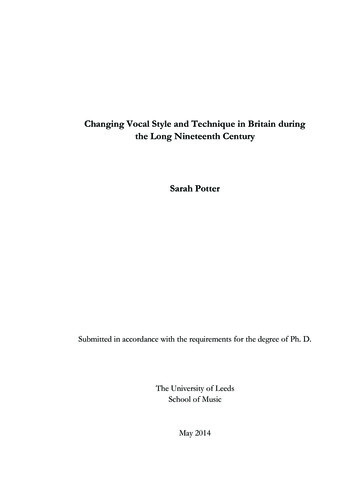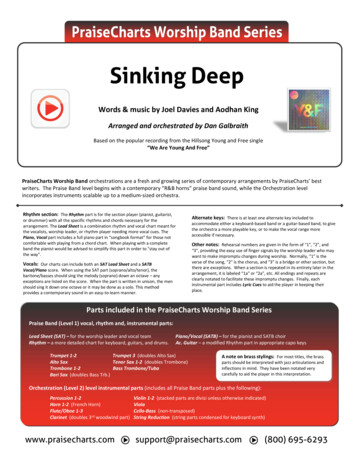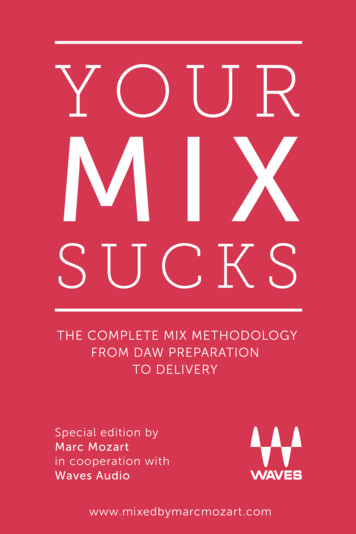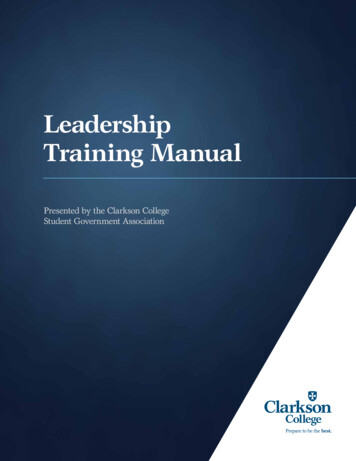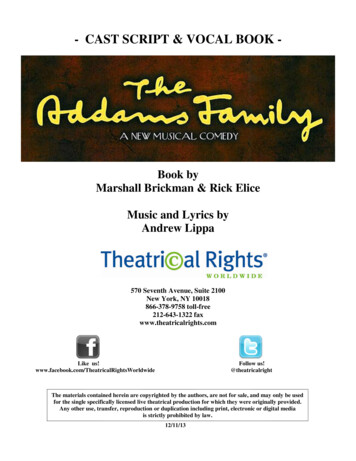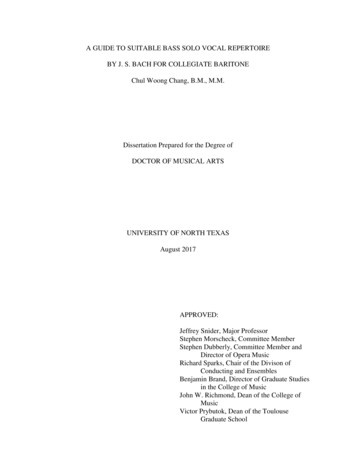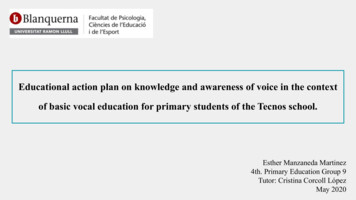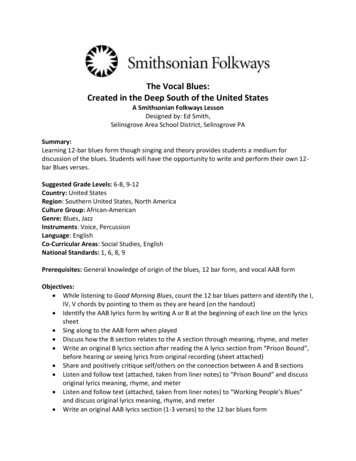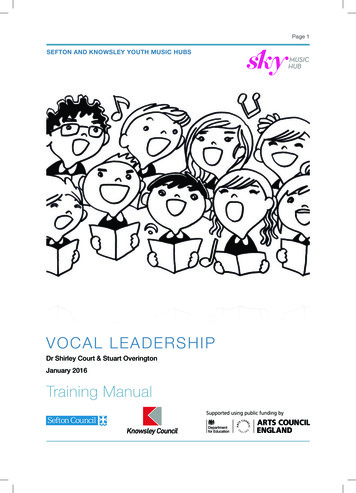
Transcription
Page !1SEFTONSEFTON ANDAND KNOWSLEYKNOWSLEY MUSICYOUTH HUBSMUSIC HUBSVO C A L L E A D E R S H I PDr Shirley Court & Stuart OveringtonJanuary 2016Training Manual
Page !2SEFTON MUSIC EDUCATION HUBOverviewForwardMIDAS(Music ImprovementDevelopmentVisits) clearly identified that many schoolsCHAPTERONE - WHEREDO andWESupportSTART?3required support to develop singing for their pupils. In response, Shirley Court and Stuart Overingtonhaveworkedwith Sefton and Knowsley Music Hub to provide support for curriculum staff in schoolsWhatis Engagement?3through Vocal Leadership Courses. The aim is to improve the experience and quality of singing –ExpectationsOwnership5whilsthaving a lot &of funtoo.This booklet reflects the course structure and contains what is essentially a summary of what works.TWO - howTHEto VOICEAS ANINSTRUMENT8IfCHAPTERyou want to experienceuse it, contactthe musichub and book onto the next course.I’m grateful to Shirley and Stuart for this excellent resource.Every Voice Matters8The Ingredients of Good Vocal Technique9CHRIS LENNIE – January 2016Choosing the right warm upOverviewExtension: How to deal with the changing voice1117CHAPTER THREE - REPERTOIRE AND BEYOND19CHAPTER- WHEREDO WE START?How do weONEchooserepertoire?Whatis Engagement?I’ve gotthe song, what next?Expectations & OwnershipTechniques to teach a tuneCHAPTER TWO - THE VOICE AS AN INSTRUMENTPlanning for progressionEvery Voice MattersCHAPTERFOUR:PULLINGALL TOGETHERTechniqueTheIngredientsof GoodVocal ITChoosing the right warm upConducting 1.0Extension: How to deal with the changing voiceStructuring a SessionCHAPTER THREE - REPERTOIRE AND BEYONDA positive learning environmentHow do we choose repertoire?RepertoireI’vegot the suggestionssong, what next?Techniques to teach a tunePlanning for HAPTER FOUR: PULLING IT ALL TOGETHERConducting 1.0Structuring a SessionA positive learning environmentRepertoire suggestions2727282929
Page !3SEFTON MUSIC EDUCATION HUBChapter One - Where do we start?IN THIS CHAPTER WE WILL: Explore what we mean by engagement and the characteristics of an engaging vocal leader Discuss techniques in order to be a more engaging vocal leader Identify the importance of high expectations and pupil ownership in order to produce high quality singing Look at specific ways in which one can aid pupil ownership within singing sessionsWHAT IS ENGAGEMENT?ENGAGEMENT IS WITH BOTH THE INDIVIDUAL AND THE ACTIVITYIt is important to understand that we engage our singers on two different levels Personal level as Teacher/pupil In the activity of singing itself singing in the classroom, singing in choirs, singing as part of a massedchoir/ singing day.5 QUALITIES OF AN ENGAGING VOCAL LEADER1. Creating the Safe environment to be able to motivate and communicate. Be caring and interest everyone as a human being first. Respect for one another Praise Smile, warmth, friendly eye contact, Flexibility Confidence in what you are doing.
Page !42. Vocal Health and sound subject knowledge Knowing how the voice works and having a variety of strategies to be able to pass on this knowledgeto young people in a clear and simple way. “If you can’t explain it simply you don’t understand it properly.” Einstein Progression in singing3. Leading by example Role as an enabler. To start and finish the song. Know what you want from the song. Understand your body language and how to communicate what you want from the song Be a good listener. Appraise the situation and apply your experience and knowledge.4. Teaching Strategies Discipline-clear boundaries and expectations. Pace of rehearsal and variety. To know when to step back and to stop leading and support. Listen and Appraise throughout the session. To have fun whilst learning.5. To Understand Musical skills Pitch and Rhythmic accuracy Diction Timbres Dynamics Phrasing Communication & Expression
Page !5E XPECTATIONS & O WNERSHIPHAVING GOOD QUALITY EXPECTATIONSIt is vitally important that we have the right expectations for our singers. If they are too low then they will neverachieve their full potential and settle with just ‘singing along’. If they are too high then they will becomedisengaged and disheartened and recognise their own progress.Whilst it is good for us to know these expectations it is even better if we communicate these to the youngpeople and give them ownership of their singing.ActivityWatch the following YouTube clips and discuss the quality ofeach performance. How does it compare with what you wouldexpect for singers of that age group?https://www.youtube.com/watch?v kAJ1w5U7jxIhttps://www.youtube.com/watch?v q4CHKlC6QbUhttps://www.youtube.com/watch?v 22OBQw4qTyYTHE VALUE OF OWNERSHIP OF THE SINGING BY THE CHILDRENOwnership happens when ; They are actively involved in the process of developing their own singing as a group. They know and understand your expectations of them as a group. They are actively involved with gestures and can lead some of the singing. Opportunities are given for thechildren to come and LISTEN at the front of the class. They understand what good singing looks and sounds like and have ways in which to identify it. It is a good idea to have a check list of things that they can easily latch on to.
Page !6A COMMON MUSICAL LANGUAGEIn order to do this you need a language that both you and students can use to assess and evaluate theirsinging and performing.We all observe most effectively when we are given things to look out for. Therefore if you give young peoplespecific things to look out for when observing the group we can hope to avoid the “it was good” situation.THE ‘E’ WORDS & THE ‘F’ WORDS!‘E’ Words are the good ingredients in singing. There are lots of words beginning with ‘e’ that make goodquality singing. If you ask the students they may be able to come up with some but a few good staple pression EarsOn the other hand ‘F’ words are bad (it may be best not to ask for examples from the groups for this one especially teenagers)FussingFaffingFidgetingWith these words established you have a flexible resources which you can refer to and add tothroughout the time you work with the group. They may themselves find new words or even make upwords to describe good or bad features e.g. Foghorning!DETECTIVES AND PEER ASSESSMENTOne of the most effective ways in which to give students ownership over their singing is by getting individualsto listen to the rest of the group. Not only does this give the individual the unique chance to hear what thegroup sound like all together, it also lets the rest of the class hear from their peers (as well as you,) the chanceto listen more carefully.Each detective gets a card with a series of questions outlining what he or she is looking for. They then caneither look out for individuals or assess the whole group. There are a number of different detectives that can beused, below are a few of examples:
Page !7POSTURE DETECTIVE CLUE CARD Are they standing with feet apart- one foot under each shoulder? Are their shoulders down and relaxed? Are their knees loose? Do they have a tall giraffe neck or are they doing a good Meerkat impression?TV DETECTIVE CLUE CARD Are their eyebrows working to add interest to their facial expression? Are they using the right expressions for whatever the song is about? Do you believe what they are singing about? Are their bodies and face telling the story?DICTION DETECTIVE CLUE CARD Are the words clear? Can you hear all the t’s and d’s at the ends of the words? Are all the mouths in a unified shape? Is everyone trying to bite into the words like biting into a granny smith apple? Is anyone exaggerating their mouth shape so they look and sound distorted?PUTTING IT INTO PRACTICEAnswer the following questions for each of the types of student you may meet below How do you engage the following? Are there any ways in which you may do this more effectively?1. The reluctant singer Classroom situation/choir2. The chorister Gifted and talented within a classroom situation3. The reluctant singer in a choir .4. The “soloist” within a choir!
Page !8Chapter Two - The Voice as anInstrumentIN THIS CHAPTER WE WILL: Explain the fundamental aspects of vocal technique Discuss the importance of good vocal knowledge in teaching singing Identify engaging ways in which to ensure there is good vocal practice within singing sessions Look at the ingredients if a good warm Look at the challenges of 'changing voices'EVERY VOICE MATTERSOUR OWN INDIVIDUAL VOICEThe voice is an individual instrument, and we should allow children to use whatever instrument they have tothe full. Think about a baby. A baby recognises the sounds of its mother’s voice. Babies all cry, laugh etc. butthey are all unique. There is a difference in our natural voice pitch, timbre, inflection, accent, and expressionwhich is why we recognise people's voices on the telephone.It is important that we all understand that all babies are born with the potential for a singing voice and thereforewe must understand that every voice has potential and must be treated with that respect.LIMBERING UP - WHY DO WE WARM UP?Time is against you as always. You really need to get into the song to prepare for the concert and youstart to think, do we really need to warm up? The answer is always,” Yes!”Not only is a warm up important part of the session but, I would argue, it the most important part of asession. Healthy singing involves the whole body; just as athletes warm up their muscles before a race, singersneed to warm up both the body and the vocal folds before singing. A good warm up also helps get rid of any tension in the body, so it should always be fun!
Page !9 Songs and warm ups that involve actions help focus attention and also demonstrate whether a child isconcentrating. Brains and bodies need to be mobilised and energised before they receive new information.THE INGREDIENTS OF GOOD VOCAL TECHNIQUEThe best way in which to approach a warm-up is to think about the fundamental components of good vocaltechnique which you are preparing your singers to do. The warm up the provides the opportunity not only tofocus the group but to revise and refresh these before you move onto the main rehearsal.1. Posture The body supports the voice, so standing or sitting badly will affect the quality of the vocal sound. Stretch both arms right up above your head and set your eyes on a spot on the ceiling. Drop the armsslowly at your sides while still looking at ceiling. Then drop your head slowly so that you look straightahead of you. The feet should be slightly apart (roughly shoulder width) so that the balance is secure and the kneesare not locked. The shoulders need to be open but at the same time relaxed. Check for tension in thenecks. The arms should be loose at the side. A shake out of hands wrists, feet, ankles, drawing a number 8 with their knees any activities that leadto the whole body feeling “floppy” are what is needed.2. Breathing The best way to learn to breathe in is to concentrate on breathing out and explore what the body doesnaturally. It is ok to feel a nice rounded tummy full of air! Ladies and young teenage girls find this a problem as they spend most of the time trying to holdtummies in!! Try exhaling on a zzz like a bee and talk about ‘releasing’ when you breathe in. Make sure the shoulders are not rising when you breathe.
Page !103. Different Vocal Qualities It is important that students learn to use the full vocal range and develop an understanding of voiceregisters Voice registers can loosely be described as ‘sections’ of a voice and it is really important to understandhow to help children access these so they can use their full vocal range. Ask the children to imitate the sound of a puppy whining outside a window, wanting you to let him in,or to make throw an imaginary ball high in the air and make a “whee” sound at the top of your voice. Getting students to start in the tilt/head register sing or slide down the scale can help avoid vocal‘breaks’ (especially with girls 11 - 14)4. Performance & Communication Music, and particularly singing, is a performing art and so expression, intention and communicationshould always be present in our work. Some children are more confident that others. It is often good to use focus exercises to explore facialexpression and avoid young people looking at one another at first. However it is important that the young people have ownership of the performance. asking questionslike what do you think this song is about? How do we want the audience to feel? can be very useful.5. Ensemble & ‘Blend’ This is not something you would necessarily look at until the group were at a good competence ofsinging. Encouraging singers to listen across the choir is a simple way in order to increase awareness. Blended sound comes predominantly from unified vowels shapes. Spend time looking at the openvowel sounds and mouth shapes, AH, EH, EE, OH, OO. Find ways of remembering the differentshapes. With older, more confident singers, you can get them to individually join the sound adding to it withoutbe noticeable.
Page !11THE HEAD/CHEST VOICE DILEMMAWhilst I am not the biggest fan of the terminology ‘head’ and ‘chest’ voice (ideally the wholebody should be resonating throughout the vocal range!) there is no question that there aredifferent vocal registers:Speech quality (chest voice). This is the speaking vocal range of a singer (the larynx is in aneutral or resting position). You will hear speech quality singing in pop and music theatresinging. However, if you try to take speech quality too high in your range (above the F abovemiddle C) it will feel very uncomfortable and sound a bit shouted and strained. This is pointwhere you need to open up the next section of the voice – sometimes called head register orsinging in tilt.Tilt/head register. Children can very easily get stuck in the lower end of their voice and singonly using inflected speech. This may be because they have never had the opportunity toexplore their own voice or have never been shown ways to do this. . To visit the next ‘section’ ofthe voice the larynx needs to tilt forwards (hence the term tilt!). Children need to use this part ofthe voice regularly; they need to learn how to make a safe healthy sound in this part of the voice,otherwise they will always find many songs too high.Of course, you may choose to use speech quality for the lower notes in a song, but childrenneed to learn to make a clear, safe and healthy sound in their higher register or they will alwaysfind many songs too high.CHOOSING THE RIGHT WARM UPOnce we have established what we are warming the voice up to do we now have to decide on the materialswe are going to use to do it. There are a lot of materials out there from fun songs to simple exercises which all‘warm up’ the voice. What is key, however, is to understand what role each activity is having in the warm up.PHYSICAL WARM UPS & FOCUS ACTIVITIESThe first part of many warm ups is a focus activity or a physical warm up. The value of these activities are toget rid of tension from the body as well as focussing the group to a teacher-led activity, this is particularlyeffective when they are led without speaking!Physical warm ups and focus activities may involve ‘copy cat’ physical gestures or using simple ‘brain gym’movements. A more developed version of this may be learning a body percussion or just call and respondingvarious rhythms.
Page !12CHANTSChants are a valuable link between using the talking voice and developing the singing voice. They also helpteach and embed rhythms and can be a ‘way in’ to musical material covered later int he session.Try chanting the rhyme in a variety of different voices e.g. posh, fairy, twangy like an American Cowboy. Givethe children opportunities to choose which voice to use. This can be later developed into a two-part canon,with the second group entering on the second line. When the children are confident you can try chanting afour-part canon.VOCAL EXERCISES, SIRENS AND SIMPLE ROUNDSUsing chants or intoning, a heightened form of speech, prepares the group well to move into vocal exercises.Try to avoid moving straight into more traditional sung exercises with less confident or experienced groups asthis can seem very alien to them. Start by using simple features that come out of speech, always modellingfirst, for example singing ‘Yer, yer, yer, yer, yer’ up and down and arpeggio. Use gestures and scenarios to helpcreate an open healthy sound.You can also take chants and singing them to a scale, for example:What a to do to die to day at a minute or two to two!A thing distinctly hard to say but harder still to do!!PUTTING IT INTO PRACTICEAn effective warmup not only prepares the young people to sing but also guides them into the repertoire/learning objectives of the session.Plan an example of a 10 minute warm up for the following sessions:1. A whole class singing session focussed on pulse and rhythm2. A school choir session working on a beautiful, legato song3. The final choir rehearsal before a public performance
Page !13EXAMPLE REPERTOIREKS1/2ChantsAll I want is a proper cup of coffeeMade in a proper copper coffee potTo begin to toboggan first, buy atoboggan.But do not buy too big a toboggan!I may be off my dot but I want a propercoffeeToo big a toboggan is too big a tobogganIn a proper copper potTo buy to begin to toboggan.Tin coffee pots and iron coffee pots(Singing Sherlock 4)They are no use to me [clap, clap]If I can't have a proper cup of coffeeIn a proper copper coffee pot, I'll have acup of teaSee also - Lickety Split (Sherlock 2)(Singing Sherlock 2)SongsTo the tune of Frere Jacque:I’m alive, alert, awake, enthusiastic,Harry Potter, Harry Potter,I’m alive, alert, awake, enthusiasticWhere’s he gone?I’m alive, alert, awake,Where’s he gone?I’m awake, alert, aliveRun off with HermioneI’m alive, alert, awake, enthusiasticRun off with Hermione,Poor Old RonPoor Old RonSee also - My Dog is a Good dog(Sherlock 2)
Page !14All round Warm UpVOCAL WARM UP RAP (Sherlock 4)Kaye Umansky(To be performed with a steady beat tapped on rhythm sticks or a cow bell)Gotta energise the body,Gonna pump those lungs,Gotta get the body ready,(Ss, ss, ss, ss, ss, ss,)Gotta feel that beatGonna dive in the lake,And we gotta keep it steady.(Wheeee – voice slide)We’re in the mood,Gonna work those tongues,We’re in the know,(Stick tongues in and out)Get ready, get set,Gonna shiver and shake,And here we go!(Brrrrrrrrrrrrrr!)Then we strike a poseAnd make a stand.WARM UP AND STOMP (Sing Up)(Each line is delivered in a call and response form)Up and a down and a forward and a back x 2 (American accent) - shoulders moveRound x2 (Posh voice) - shouldersThis way and that way and this way and that way (whispered) - turn your bodyTouch the ground ———— up (vocal slide) - as it saysEee ee ee ee ee ee ee ee x2 (nasal witchy sound) - point fingersShhhh, shhhhhh - Ski movement1,2,3,4,5,6,7,8 x 3 - first clap, then click, the turn around
Page !15EXAMPLE REPERTOIREKS3/4ChantsCha cha chikka chikka,Cha cha chikka chikka,Cha cha chikka chikka,Cha cha cha.How much wood would a woodchuckchuck,If a woodchuck would chuck wood?I know you got a cheque, gotta check,I know you got a chequeChikka chikka cha cha,Chikka chikka cha cha,Chikka chikka cha cha,Cha cha cha.I know you got a cheque in the post,check!Right, rightRight in the middle of the kitchen floorI left, left,Cha cha cha cha cha chaLeft my jar of Branston pickleCha cha cha.Mm cha, mm cha, mm cha,Mm cha, mm cha, mm cha,Mm-cha mm-cha mm-cha,Mm-cha mm-cha mm-cha,Cha cha chaTry alsoVarious tongue twisters:To begin to toboggan bibeddy bobbedy bibbedy booSee www.uebersetzung.at/twister/en.htm
Page !16SongsFirst you make your fingers click,My dog is a good dog, yes he is.Then you stamp your feet.My dog is a good dog, yes he is.Both hand slap your knees,For he sits and begsAnd clap on the beat.And he stands up tall(Sing for Pleasure - .)He’s shaking his tale all around the hall.My dog is a good dog, yes he is.A, B, C, D,E, F, G,H, I, J, K,L, M, N, O, P,Q, R, S, TMy dog is a good, good, good dog, yes heis.My dog is a good, good, good dog, yes heis.For he sits and begsU&VW, X, Y, ZSomewhere over the rainbow,And he stands up tallHe’s shaking his tale all around the hall.My dog is a good, good, good dog, yes heis.way up high,Theres a land that I heard of5 x good, 7x good, 10 x good Once in a lullabye.(Singing Sherlock 2)RoundsThere are a number of rounds available try some of the following: Kookaburra sits in the old gum tree Shalom, my friends Tomorrows another day Popocatepetl Heigh ho, nobody’s at home Belle MamaVarious books including Roundabout, Sing for Pleasure books and also see www.totalchoirresources.com
Page !17EXTENSION: HOW TO DEAL WITH THE CHANGING VOICEOne of the most feared aspects of working with young people’s voices are ‘changing voices’ the papered inwhich boys (and girls) voices change through adolescence. This is a key period in vocal development and thewrong approach can lead to loss of confidence, vocal technical issues and ultimately disengagement in singingfrom older students.There has been a great deal of research into changing voices and lots of studies into how to best work withyoung people during this age however it is important to stress that there is no ultimate solution. Just as everyvoice is uniquer the way and rate in which they change is also unique. As well as this, vocal change is aproduct of a hormonal change in the young people. This has psychological, physical and social repercussionsall of which can effect how young people engage with singing.VOICES ‘CHANGE’ THEY DO NOT ‘BREAK’Important things for teachers and children to know about a changing voice Boys’ voices don’t change overnight. What we notice is lower pitches developing so it appears that thechange occurs very quickly. However these lower pitches are only a part of the process. Puberty in boys can start as early as 10 and as late as 14, however the onset of puberty is trending younger(with girls this trend is Katy a much faster rate) Voice training cannot alter the stage of the change (we cannot change physiology). Nevertheless good vocaltraining does assist young people in sinning through that changing process. Generally boys will mimic what the hear from a teacher. If a teacher is singing at the bottom of their rangethey will do the same and so sing excessively low.WHAT ACTUALLY HAPPENS WHEN THE VOICE CHANGE Boys (usually ages 12 - 18)Girls (usually ages 11 - 14)Speaking voice depends firstSpeaking voice lowers slightlyLarynx grows about 10mm and drop about an 8veLarynx grows about 3-4mmThickness of the vocal folds changesIncreased breathiness, huskiness, hoarsenessBaby fate drops away: muscle developsin security of pitchBrain has to relearn all intricate muscle controlNoticable register breaksBreaks or cracking in voice may occurDecreased and inconsistant pitch rangeDifferent researchers have labelled the change in boys voices in different ways, as shown below.
Page !18Less research has been done on girls changing voices but Lynn Gackle refers to them as:Stage I:UnchangedStage IIa:Pre - Menarcheal (ages 10-11)Stage IIb:Post - Menarcheal (ages 13-14)Stage III:Young Adult Voice (15 )HOW TO GET THE MOST OUT OF CHANGING VOICES The more you and the young people understand about the vocal change the easier it is to acknowledge andwork with. Allow young people to feel ownership of their voice through the change not feel ashamed aboutit. When warming up encourage young people to use the full extent of their vocal range from the highestsound to the lowest sound wherever their range lies Make sure you choose repertoire that fits the voice not the other way around Most the time when young people ‘don’t like’ a piece it is either because they haven’t tried it or they find itdifficult to sing. Be wary of doing pieces you feel they will find ‘cool’ and try and look at the vocal rangeinstead. Be prepared to transpose the music into helpful key if needed. Boy’s whose voices are just changing thinkabout C, Db & D major/minor. Do not avoid vocal breaks but tackle them head on. Work from above the ‘break’ downwards with girls inparticular.FURTHER INFORMATIONMuch of this information has come form notes from Martin Ashley a leading voice in this field working at edgehill university (ashleym@edgehill.ac.uk)Other fantastic practitioners include caroline Gale at Guildford County School, Surrey (www.boys-keepsinign.org) and Don Gillthorpe (don@gillthorpe.co.uk) who has a range of material especially arranged withcambiata parts.
Page !19Chapter Three - Repertoire andBeyondIN THIS CHAPTER WE WILL: Discuss the challenges of choosing repertoire for signing within schools Look at how repertoire can be used to aid progression in singing and musicianship Explain some simple teaching technique to help teach melodies Explore the idea of planning for progression, what it means and how we can implement it in our work.HOW DO WE CHOOSE REPERTOIRE?Choosing the right repertoire can be key to getting the best out of your young people. There are many factorsto consider: what do you need to young people to learn about? how challenging do you want the piece to be?what range should you use? and many more.WHERE TO START Find your baseline starting point: if your first task is just to get them singing, start with repertoire that the pupilsenjoy, or that will capture their enthusiasm. Once you have won them over you should begin to stretch themby introducing music that they are less familiar with.Think about: Tuning in voices with songs of a narrower pitch range & Call and response songs which lays the foundationof part songs. (for example: Doobidoo Sue Nicholls from Song Stack, Maleesway Sherlock 2, JawsSherlock 2) Variety: e.g. unison and part-singing. Suitability of words and content Expressive techniques: e.g. dynamics, phrasing, legato and staccato. The range of notes - Think about the experience of the children in front of you. Rememberthat the pitch of a song needs to suit children’s voices -not yours! E to D’ is a good starting point. (KS3 lookat the changing voices section above) If all the songs lie in the chest voice they will never learn to use their head voices.
Page !20 The B-flat next to middle C is probably as low as most 8 -12 year olds should sing comfortably. Mostchildren should be able to sing an E/F at the top of the stave. Be aware that some popular and contemporary songs lie too low for youngsters. Also, many pop songs donot sound as they are written in the sheet music.THE PATH TO PART-SINGINGWhilst part singing is a fantastic thing to aim for in our groups it is important that we do not try and run beforewe can walk.A normal progression route in a primary setting may look like this:Unison SingingSongs in which all the children sing the same part.Call & Response songsSongs in which there is a leader which sings the 'call' and the group echo a 'response'this can be done with either the teacher as the leader or with the class split into twogroups.RoundsSimple songs which are repeated many times. Different groups can be brought in atpoints through the melody overlaying the tune to create harmonies.Unison Songs with descantsThese are songs in which there is a main melody that the group sing but then a smallergroup can sing a simple harmony which is higher in pitch than the tune.Partner SongsThese are sets of songs that can be sung at the same time as one another. Forexample swing low sweet chariot and Oh when the Saints.
Page !21In a upper key stage 2 and into key stage 3 we may look to develop this further:Layered songs/ OstinatosSongs which feature repeated melodies or ostinatos that layer to create differentparts. These will commonly involve a melody that goes alongside the ostinatosSimple repetitive harmoniesHear the harmonies are very simple melodically and repetitive so that once learntthey are constantly reinforced though the songParallel ’gospel’ harmoniesAs we begin to develop further we may use gospel harmonies. These harmoniestend to follow the shape and rhythm of the melody but lie either below it (alto) orabove it (tenor)Full 3 or 4 part singingThis is where we look at traditional harmonic choral writing where harmonies workindependently from the melody.As the young people develop it may be that you have to move backwards to move forwards sometimes,especially with changing voices. The important thing is that you take the group with you allowing them todevelop as a whole group with the support and confidence of their peers.
Page !22I’VE GOT THE SONG, WHAT NEXT?Choosing the repertoire is one thing but it’s what you do with it that count.PREPARATION IS KEYIt seems obvious but the more prepared you are then the better the session will go. Think about the following: How are you going to introduce the song? Decide on style, character and speed of the song. How can you get them into the character of the song inthe warm up time? Look through to see if there are any big leaps that may cause problems . How are you going help them.(Ofsted say “Don’t tell them how Show them how!!”) Are the rhythms tricky? Would it help to chant it through first!( If they can’t say it together they won’t be ableto sing it!) Will actions help them learn the words? Do you want actions in the final performance? What voice qualities does the song require- Twang, Sob, Aspirate? Decide on where you want the children to breathe. Are they going to stand together in lines are groups? Are you going to have soloists or small groups singing some parts? Which warm ups can you use to get into the song? (- song with several leaps or one that lies vocally quitehigh you may
Personal level as Teacher/pupil In the activity of singing itself singing in the classroom, singing in choirs, singing as part of a massed choir/ singing day. 5 QUALITIES OF AN ENGAGING VOCAL LEADER Creating the Safe environment to be able to motivate and communicate.
